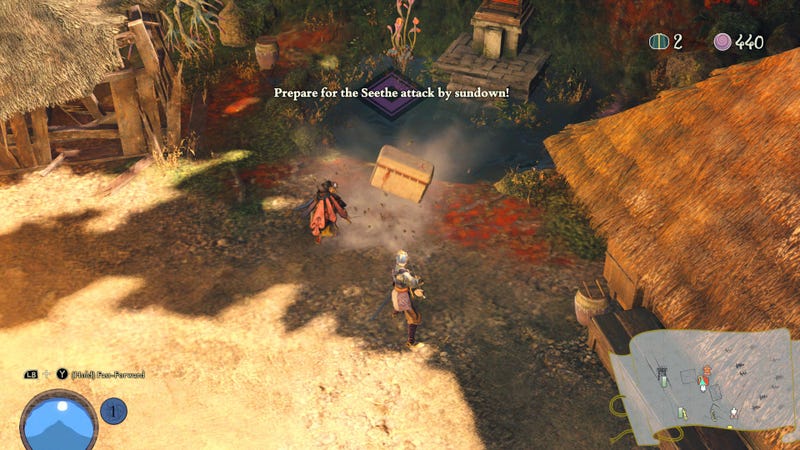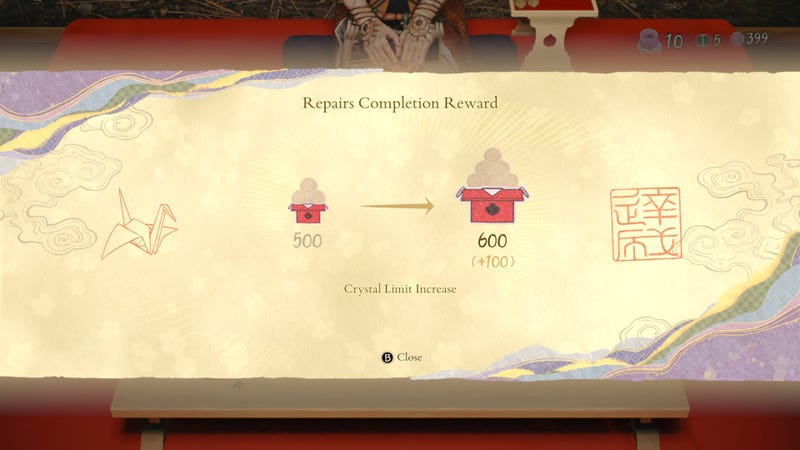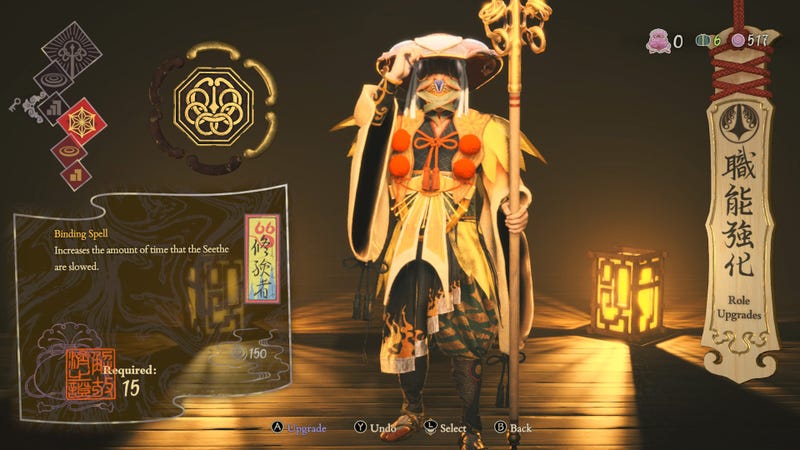Kunitsu-Gami: Path of the Goddess is half tower-defense, half action game all about assisting a maiden to purge malicious defilement from a mountain. Seems simple enough right? Not so fast. It doesn’t take long for everything to expand and become more complex than you’d expect.
Read More: Kunitsu-Gami: Path of the Goddess: The Kotaku Review
There are many in-game tutorials covering the basics, but the addition of new mechanics can feel quite imposing. These tips will help you efficiently prepare to take on the Seethe: the enemies of Kunitsu-Gami: Path of the Goddess.
Focus on villagers and defilements during the day
While most stages are finished by the protagonist Soh carving a spirit path for the maiden Yoshiro, this won’t be your top priority in preparing. There’s plenty to do during the day and the latter stages are even more complex, but your primary focus will be on rescuing villagers and purifying the hanging defilements to earn crystals. Aim to complete these to ensure that you’re combat-ready once the Seethe come at night.
Be mindful of where you leave Yoshiro
Slain villagers can be rescued again after the night ends and Soh will enter a temporary spirit state if their health is depleted. These luxuries aren’t offered to Yoshiro though, who can trigger a game over if she takes too much damage. What makes her more fragile is that she essentially becomes a sitting duck after the sun sets.
You’ll need to be wary of where she’ll be at night. If she’s expected to start the night in the open with lots of paths, consider having her stop earlier in a safer area. Ideal spots will be behind a repaired barrier or within a ward, the latter of which can damage enemies. It’s okay to take your time since she won’t be able to cross a stage in one go anyway.
Keep the Carpenter busy
Early on you’ll meet the Carpenter NPC, who can be ordered to repair various contraptions on a stage during the day. Whether it’s a barrier to stall the Seethe’s advance or a platform for archers, fixing up contraptions will make a huge difference in battle.
Have this NPC repair things as often as possible. It’s an absolute waste to not use an NPC that doesn’t count as a villager and who’s only available during the day. Any progress they make is also saved for the next day, so don’t hesitate to order them to work on something you know they might not finish before nightfall.
Reassign your Thieves before night

The Thief is a fantastic utility role that you’ll acquire after a handful of stages. It’s the only NPC that can dig up the half-buried chests you may have noticed before. Their only drawback is that they won’t participate in battle against the Seethe at night.
Changing their roles as evil spirits attack isn’t the greatest time, which is why I do it right before the sun sets. If you’re unsure whether they seem worth the numerous crystals to change their role twice, I can assure you they are. There’s a good chance a chest they dig up will have a ton of crystals if not Musubi.
Purify animals for rations
You’re bound to come across animals covered in defilement during the day. They’ll flee as you approach and won’t stop until they’re far away. While they might seem like a waste of time to deal with, hitting some can be a big help. Your weapons might be able to slay evil spirits and break pots, but attacking a defiled animal will simply purify it and drop a ration. Consider helping these creatures out with a good whack if you or the villagers need to recover health.
Respec your upgrades whenever you want
Kunitsu-Gami is just as much a strategy game as it is an action one. A lot goes into preparing for new stages, including when you upgrade your villagers at your bases. The good news about this mechanic however is that your choices don’t have to be permanent.
Upgrading requires the less-than-common Musubi resource, but you can undo every upgrade you’ve made if you want. That means if you’re about to tackle a stage that doesn’t benefit a particular villager role (such as a Thief in a boss stage), it’s best to remove the applied Musubi and use it on a more relevant role instead.
Come back for bonus objectives later
The desire to immediately replay a level just to knock out the new bonus objectives is relatable. False confidence is a hell of a thing when you’re fresh off beating a stage and realize you can earn rewards such as Musubi or Mazo Talismans. But Kunitsu-Gami: Path of the Goddess is not a game you typically want to do that with.
Destroying all the pots on a stage is certainly doable, but defeating a boss under a certain time or completing a stage without using rations is incredibly easier after you’ve unlocked more things. Come back after you’ve amassed more upgrades and villager roles to finish these objectives with ease.
Visit your bases and issue repairs

Successfully purifying a non-boss stage will turn part of it into a base for the local villagers. Outside of the various options available inside Yoshiro’s tent, you can walk around and request help in repairing the broken-down areas of the stage. Rewards include collectibles (Sweets and Ema Plaques respectively) in addition to Musubi. Completing every repair for a base will increase the maximum limit for your crystals and occasionally your rations.
Keep in mind that progress is only made on these by completing stages. If you want the rewards for a repair and don’t want to wait to complete the latter lengthy stages, you can rush through them by tackling an earlier boss stage.
Don’t Hoard Your Crystals and Rations
The limit for crystals and rations I mentioned earlier only applies outside of the stages themselves. You can accumulate and use as much as you want during a level, but any excess is lost once the stage is completed. It’s a waste to be overly frugal with these—keep everyone healthy and feel free to re-assign any villager roles.
Take a breather in the Command menu
Every stage in this game introduces new mechanics, enemies, and level designs, resulting in a rising complexity. It’s completely normal to feel overwhelmed as the maps and villagers you have to watch over increase in size.
I recommend taking small breaks by entering the Command menu. The Pause menu might be a more comfortable way to take a break, but the Command menu will let you view your immediate surroundings for as long as you want and see the health of every villager.
Don’t sleep on the Ascetic Role

Defeating the second boss will reward you with the option to assign the Ascetic Role to villagers. It’s a pretty unique villager type since it acts as more of a de-buffer. They’ll summon a barrier around themselves that slows down any enemies that pass through it. This ability works on common enemies and bosses alike, making it much easier to inflict damage between their attacks.
Keep upgrading Ascetics and the barrier will become more effective across a larger area. The final upgrade allows the barrier to cause damage and lower enemy defense. Speaking from personal experience, the Ascetic has villager has saved my ass more than anyone else and rightfully earned a mainstay spot for most stages. Keep them around and you’ll be set.
Upgrade Soh
Partway through you’ll become able to upgrade Soh with Musubi too. This results in the balancing act of where to spend them all the more tricky. That being said, I do recommend putting a considerable amount of Musubi towards Soh.
You’ll gain access to a variety of combat-oriented skills such as new weapons (including ranged arrows!) and attacks, as well as additional Mazo Talismans and Tsuba Guards to equip. The command screen can also gain a few new convenient options such as being able to rally multiple villagers to one location or ordering Yoshiro from anywhere on the map.
Kunitsu-Gami: Path of the Goddess is a challenging game, but taking advantage of its many mechanics to find the right strategies is the key to venturing further down the mountain.
.

Leave a Reply